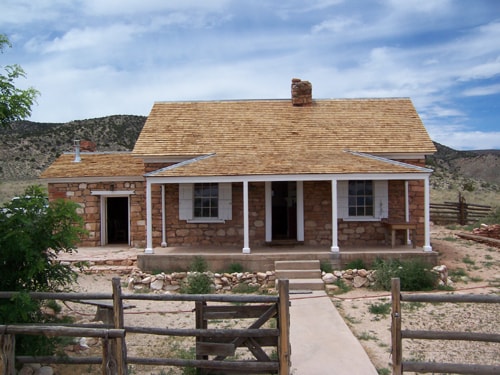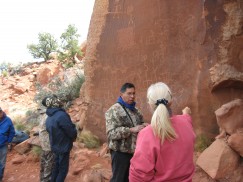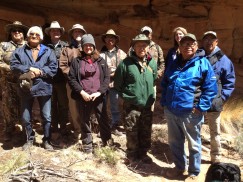- Home
- >
- Preservation Archaeology Blog
- >
- Tribal Consultation in the Kaibab National Forest ...
Today’s guest author is Connie Reid, an Archaeologist with the Kaibab National Forest:
“Sometimes you get homesick, but here you don’t. It feels normal and like you were back to where you were before. You have a sense of being. Everything is there and you can feel it. You don’t have any feelings of being out of place.”

Those were the words of Gerald Hooee, Sr., an elder from the Pueblo of Zuni who participated this spring in a tribal project at the Grand Canyon Trust’s Kane Ranch.
For five days in April 2013, elders from Zuni Pueblo and the Hopi Tribe stayed at the historic ranch headquarters on the Arizona Strip north of the Grand Canyon. With agency cultural preservation staff, the elders visited ancestral cultural sites on the Kaibab National Forest and Bureau of Land Management’s Vermilion Cliffs National Monument.
The Kaibab National Forest heritage program organized the project. The heritage program works closely with tribes in holding government-to-government consultation about Forest Service management activities, and in facilitating opportunities for tribal members to visit their ancestral lands and share their knowledge and perspectives.
Each day during the windy, chilly week, the participants visited prehistoric farming landscapes, pueblo ruins, rock art sites, and natural springs, and they collected traditional plants. Back around the ranch dining table in the evenings, with the coffee pot on the stove, they shared their stories, exchanged traditional songs, and engaged in lively conversations.
Throughout the week, participants discussed ways that Hopi and Zuni people could work with the Forest Service on projects of mutual interest. For example, the cultural advisers expressed how important it is to protect springs. Gilbert Naseyowma (Hopi) envisioned a reciprocal effort between the youth and elders of the Hopi Tribe, Kaibab National Forest, and Grand Canyon Trust to restore springs on forest range allotments and tribal lands. Such creative musings are often the seeds that germinate into future projects.

Representatives from both tribes said their time spent at Kane Ranch was unique for a gathering sponsored by a federal agency. Typically field trips do not involve camping together, and meetings are often held in a conference room, a venue that provides little connection with the land. They said it was inspiring to be amid the remote and beautiful Arizona Strip country, surrounded by their ancestral sites. The intimate setting allowed them to learn more about each other. Riley Balenquah (Hopi) noted, “I have a really secure feeling here and wish that more people could experience this.” Octavius Seowtewa explained that, for Zuni, the past and the present come together. “There is not that lapse of time for us (here),” he said. “We are here and they (the Zuni ancestors) are here.”
In the future, they said they would like to see campouts with Hopi and Zuni youth, and thought Kane Ranch would be a great place to bring the kids together to reconnect to the places that are part of their tribal history. The North Kaibab Ranger District and Kaibab Vermilion Cliffs Heritage Alliance have cosponsored such camps with youth from the Kaibab Paiute Tribe, and plan to work with Hopi and Zuni tribes to provide a similar experience.
Participant Gerald Hooee also expressed interest in education and job opportunities for young people. He said the Zuni Youth Enrichment Project has identified several high school and college age people interested in working for the government. Providing such job opportunities is a major goal of the U.S. Forest Service.
The April project exemplifies ways the Forest Service can make its tribal partners feel welcome and appreciated. Tribes have unique perspectives on land management, and much can be learned by working together. Informal gatherings promote exchange of information, help foster an atmosphere of acceptance between people with different cultural backgrounds and perspectives, and become the foundation for future collaboration.

Tribal participants included Gilbert Naseyowma (Hopi), Elmer Joe “E.J.” Satala, Sr. (Hopi), Riley Balenquah (Hopi), George Yawakie (Zuni), Octavius Seowtewa (Zuni), Gerald Hooee, Sr. (Zuni), and Ronnie Cachini (Zuni). Kaibab National Forest staff included Connie Reid, Britt Betenson, Mike Lyndon, Randall Walker, and Ariel Leonard. Diana Hawks and Lorraine Christensen with the Bureau of Land Management also participated. Other staff present were Roger Clark, Tony Skrelunas, and Deon Ben with the Grand Canyon Trust, and Rose Houk, Kaibab Vermilion Cliffs Heritage Alliance.
The Hopi-Zuni tribal project was made possible with a grant from former Coconino County Supervisor Carl Taylor, in partnership with the Kaibab National Forest and the Kaibab Vermilion Cliffs Heritage Alliance. The Alliance is a working group whose partners include the Grand Canyon Trust, federal land managers, local government, and academic and professional archaeologists. KVCHA’s mission is to help preserve, protect, and interpret cultural resources on the eastern Arizona Strip. Since being established in 2006, the group has received the Forest Service’s Windows on the Past award, and the Preserve America Steward award given by First Lady Michelle Obama.
For more information, visit our project pages at the website of the Grand Canyon Trust.
Explore the News
-
Join Today
Keep up with the latest discoveries in southwestern archaeology. Join today, and receive Archaeology Southwest Magazine, among other member benefits.